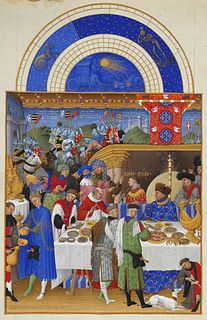
The Très Riches Heures du Duc de Berry or Très Riches Heures,, is the most famous and possibly the best surviving example of French Gothic manuscript illumination, showing the late International Gothic phase of the style. It is a book of hours: a collection of prayers to be said at the canonical hours. It was created between c. 1412 and 1416 for the extravagant royal bibliophile and patron John, Duke of Berry, by the Limbourg brothers. When the three painters and their sponsor died in 1416, possibly victims of plague, the manuscript was left unfinished. It was further embellished in the 1440s by an anonymous painter, who many art historians believe was Barthélemy d'Eyck. In 1485–1489, it was brought to its present state by the painter Jean Colombe on behalf of the Duke of Savoy. Acquired by the Duc d'Aumale in 1856, the book is now MS 65 in the Musée Condé, Chantilly, France.
British Library, Royal 1. B. VII is an 8th-century Anglo-Saxon illuminated Gospel Book. It is closely related to the Lindisfarne Gospels, being either copied from it or from a common model. It is not as lavishly illuminated, and the decoration shows Merovingian influence. The manuscript contains the four Gospels in the Latin Vulgate translation, along with prefatory and explanatory matter. It was presented to Christ Church, Canterbury in the 920s by King Athelstan, who had recorded in a note in Old English (f.15v) that upon his accession to the throne in 925 he had freed one Eadelm and his family from slavery, the earliest recorded manumission in (post-Roman) England.

The Hours of Jeanne d'Evreux is an illuminated book of hours in the Gothic style. According to the usual account, it was created between 1324 and 1328 by Jean Pucelle for Jeanne d'Evreux, the third wife of Charles IV of France. It was sold in 1954 to the Metropolitan Museum of Art in New York where it is now part of the collection held at The Cloisters, and usually on display. The book is very lavishly decorated, mostly in grisaille drawings, and is a highly important example of an early royal book of hours, a type of book designed for the personal devotions of a wealthy lay-person, which was then less than a century old. It has been described as "the high point of Parisian court painting", showing "the unprecedentedly refined artistic tastes of the time".
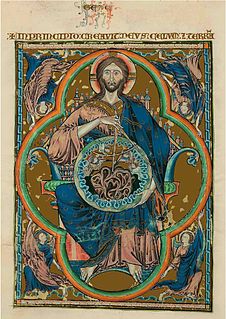
The Bible of St Louis, also called the Rich Bible of Toledo or simply the Toledo Bible, is a Bible moralisée in three volumes, made between 1226 and 1234 for King Louis IX of France at the request of his mother Blanche of Castile. It is an illuminated manuscript that contains selections of the text of the Bible, along with a commentary and illustrations. Each page pairs Old and New Testament episodes with illustrations explaining their moral significance in terms of typology. Every excerpt of the Bible is illustrated with two miniatures. The first shows a representation of the text fragment as such, the second shows a theological or an allegorical scene explaining the text fragment in the light of the teachings of the Church. The miniatures are accompanied by the Bible text and by a short comment on the typological relationship between the two images.

The Hours of Catherine of Cleves is an ornately illuminated manuscript in the Gothic art style, produced in about 1440 by the anonymous Dutch artist known as the Master of Catherine of Cleves. It is one of the most lavishly illuminated manuscripts to survive from the 15th century and has been described as one of the masterpieces of Northern European illumination. This book of hours contains the usual offices, prayers and litanies in Latin, along with supplemental texts, decorated with 157 colorful and gilded illuminations. Today, both parts of the manuscript that forms this book are housed at the Morgan Library and Museum in New York City.

The Grandes Heures de Rohan is an illuminated manuscript book of hours, painted by the anonymous artist known as the Rohan Master, probably between 1418 and 1425, in the Gothic style. It contains the usual offices, prayers and litanies in Latin, along with supplemental texts, decorated with 11 full page, 54 half page, and 227 small miniatures, decorated with tempera paints and gold leaf. The book margins are decorated with Old Testament miniatures with captions in Old French, in the style of a Bible moralisée. The full page illuminations are renowned for the highly emotional and dramatic portrayal of the agonies of Christ and the grief of the Virgin. According to Millard Meiss, "The Rohan Master cared less about what people do than what they feel. Whereas his great predecessors excelled in the description of the novel aspects of the natural world, he explored the realm of human feeling." Meiss concludes that the Rohan Master was the "greatest expressionist in 15th century France." Today, this manuscript is housed in the Bibliothèque Nationale, Paris, France.
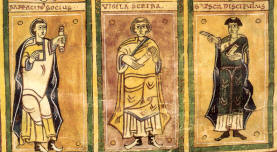
San Martín de Albelda was a Riojan monastery, whose ruins now lie within the municipal boundaries of Albelda de Iregua. It was an important and advanced cultural centre in Spain and western Europe during the tenth century.

The Isabella Breviary is a late 15th-century illuminated manuscript housed in the British Library, London. Queen Isabella I was given the manuscript shortly before 1497 by her ambassador Francisco de Rojas to commemorate the double marriage of her children and the children of Emperor Maximilian of Austria and Duchess Mary of Burgundy.

The Black Hours, MS M.493 is an illuminated book of hours produced in Bruges between 1460 and 1475, although dates as late as 1480 have been suggested. It consists of 121 leaves, most containing blocks of Latin text written in Gothic minuscule script. The words are arranged in rows of fourteen lines, and follows the Roman version of the texts. The lettering is inscribed in silver and gold, and placed within borders ornamented with flowers, foliage and grotesques, all on pages dyed a deep blueish black. It contains fourteen full-page miniatures, and opens with the months of the liturgical calendar, followed by the Hours of the Virgin, and ends with the Office of the Dead. It has been in the collection of the Morgan Library & Museum, New York, since 1912.

The Hours of Mary of Burgundy is a book of hours, a form of devotional book for lay-people, completed in Flanders around 1477. It was probably commissioned for Mary of Burgundy, then the wealthiest woman in Europe; Mary was the only child of Charles the Bold, Duke of Burgundy and wife of Maximilian I, ruler of the Holy Roman Empire. No records survive as to its commission. The book contains 187 folios, each measuring 22.5 by 15 centimetres. It consists of the Roman Liturgy of the Hours, 24 calendar roundels, 20 full-page miniatures and 16 quarter-page format illustrations. Its production began c. 1470, and includes miniatures by several artists, of which the foremost was the unidentified but influential illuminator known as the Master of Mary of Burgundy, who provides the book with its most meticulously detailed illustrations and borders. Other miniatures, considered of an older tradition, were contributed by Simon Marmion, Willem Vrelant and Lieven van Lathem. The majority of the calligraphy is attributed to Nicolas Spierinc, with whom the Master collaborated on other works and who may also have provided a number of illustrations.

The Black Hours of Galeazzo Maria Sforza, M 1856 is an illuminated book of hours, now in the Austrian National Library in Vienna. The book used to be the property of Galeazzo Maria Sforza, the fifth Duke of Milan. It was produced in Bruges, Flanders, probably between 1466 and 1477. Its name derives from its black borders and dark colour scheme, also found in the New York Black Hours, Morgan MS 493, and of a type favoured by the Burgundian court. It is one of about seven surviving black books of hours, all luxury books from the circle of the Burgundian court around this time. It is identified by some with the Black Hours of Charles the Bold that is mentioned in contemporary records, but others disagree.
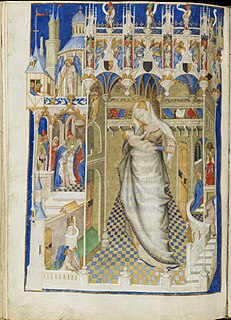
The Hours of Isabella Stuart, Duchess of Brittany is an illuminated Book of Hours produced at Angers either between 1417-18 or before 1431, in the workshop of the Rohan Master, though there were contributions from other masters, including the Master of Giac and the Master of the Virgin.
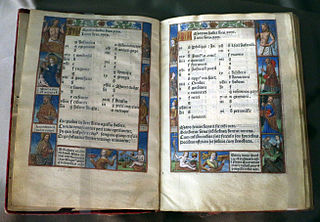
Philippe Pigouchet was a French printer and wood engraver who worked for and closely with Simon Vostre, a book keeper and publisher who planned the idea to create the fourth Book of Hours.

The Hours of Joanna I of Castile is a sixteenth-century illuminated codex housed in the British Library, London, under shelfmark Add. Ms. 35313.
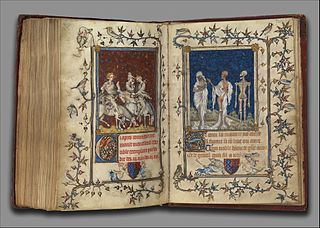
The Psalter of Bonne de Luxembourg is a small 14th-century illuminated manuscript in tempera, grisaille, ink and gold leaf on vellum. It is held in the collection of The Cloisters, New York, where it is usually on display.
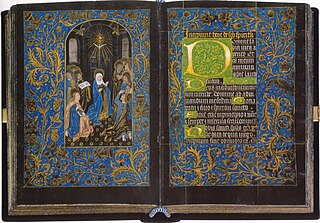
Black books of hours are a type of luxury Flemish illuminated manuscript using pages of vellum which had been soaked with black dye or ink before they were lettered or illustrated, for an unusual and dramatic effect. The text is usually written with gold or silver ink. There are seven surviving examples, all dating from about 1455–80.

The Llanbeblig Book of Hours is an illuminated manuscript in the National Library of Wales that dates from the close of the fourteenth century. Entries in the Calendar link the Llanbeblig Hours to Wales and more specifically the dedication of the church of Saint Peblig, which is marked June 6th, connects it with Caernarfon.
The Hamilton Psalter is an illustrated manuscript that consists of Psalms 1-150 and twelve canonical Odes. It is most notable among Byzantine manuscripts due to being one of the few surviving bilingual manuscripts from the Byzantine era, written primarily in Greek and Latin. There’s no sole author of the manuscript but it’s in fact a compilation of multiple scribe writing’s. Its name is derived from being a part of the Hamilton Collection, arranged to be purchased from Alexander Hamilton in 1882 by Wilhelm von Bode and Karl Friedrich Lippmann for the Royal Library in Berlin. It is currently housed within the Staatliche Museen Preussischer Kulturbesitz, Kupferstichkabinett Berlin.
























